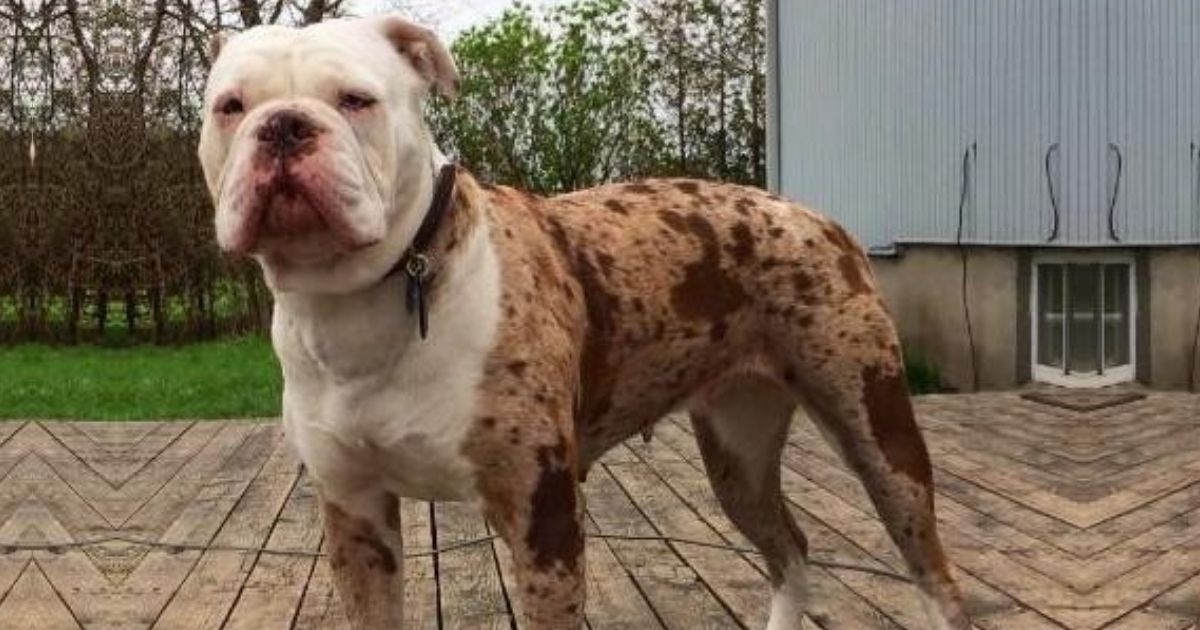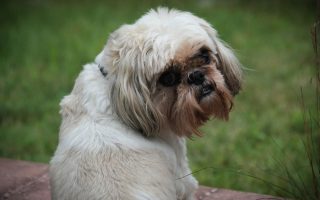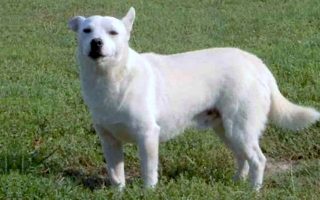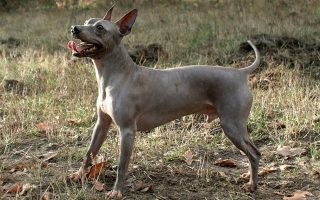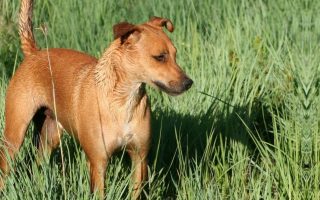The Alapaha Blue Blood Bulldog is an American breed that’s a favorite for those who love bulldogs.
With his stocky frame and broad head, his imposing looks are the quality bulldog lovers want.
If you are a bulldog lover, then you’ve come to the right place.
While this breed comes with a strong dose of challenges, they add substance to any household they live in.
Alapaha Bulldogs come from a long line of working dogs and now double as pets.
While they are not for everyone, many people show interest in them.
In this article on Alapaha Blue Blood Bulldog facts and dog breed information, we take an in-depth look at the interesting facts, characteristics, history, temperament, care, challenges, and other important aspects.
With sufficient data on the characteristics and needs of any kind, you can easily know if the dog breed is right for you and your household.
Key Alapaha Blue Blood Bulldog Information & Facts
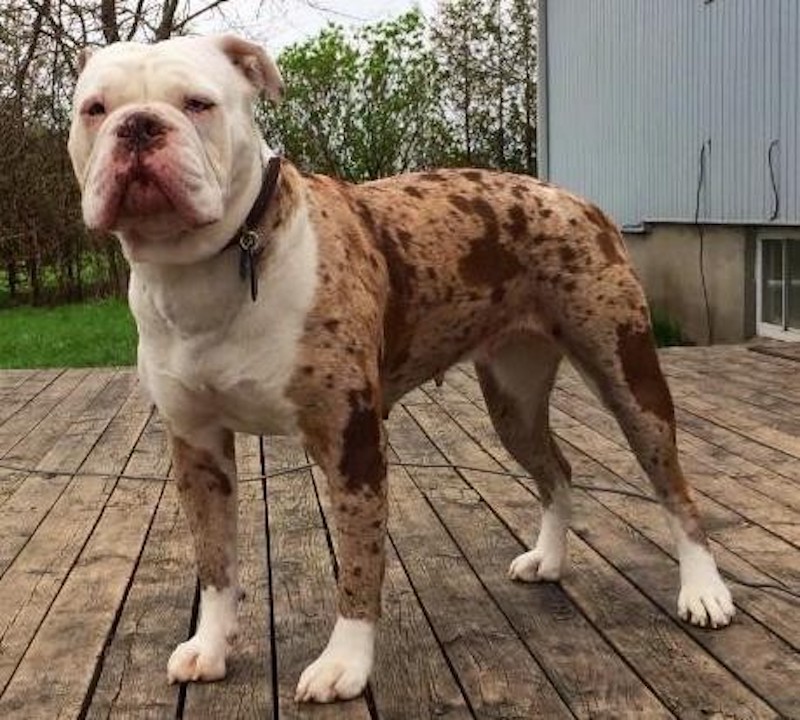
| Dog Breed Group | Mastiff |
| Height | 20 to 25 inches |
| Weight | 50 to 90 pounds |
| Coat | Short |
| Color(s) | Patched white, black, blue, brown |
| Life Expectancy | 11 – 13 years |
| Temperament | Dutiful, protective, loving, responsible |
| Origin | United States |
| Bred For | Catch dogs |
| Nickname(s) /Other Name(s) | Ottos |
| Recognized by the AKC | No |
| Recognized by the UKC | No |
Alapaha Blue Blood Bulldog Characteristics
| Characteristics | Rating |
|---|---|
| Adaptability | 3/5 |
| Friendliness | 3/5 |
| Child Friendly | 4/5 |
| Pet Friendly | 2/5 |
| General Health | 3/5 |
| Grooming Needs | 1/5 |
| Trainability | 3/5 |
| Intelligence | 3/5 |
| Playfulness | 3/5 |
| Exercise Needs | 3/5 |
| Energy Level | 3/5 |
| Tendency to Bark | 3/5 |
| Tendency to Drool | 3/5 |
| Tendency to Snore | 1/5 |
| Tendency to Dig | 3/5 |
Interesting facts about Alapaha Blue Blood Bulldog
Fact #1: Alapaha Blue blood bulldogs are rare
Though interest in the Alapaha Bulldog has increased recently, you will not find them in many households.
Not only do they have needs that cancel out some owners, but they are also rare.
At a point in history, they faced extinction. This happened after the American Civil War and the resultant losses of the south.
Bet for Buck Lance, we probably wouldn’t know this breed today.
Fact #2: They are not aggressive
Bulldogs suffer a negative stereotype perpetuated by popular culture. Their muscular frame and severe looks make people write them off as aggressive.
This is sad because they are not all given to unnecessary aggression, especially when trained.
The Alapaha Bulldog is friendly with his family but aloof to strangers. He’s not likely to attack a visitor, though.
However, if he feels the need to defend himself or his family, he does so with everything he has.
Fact #3: They get confused with a pitbull
Due to their similar looks, reputation, and close personalities, Alapaha Bulldogs get mistaken for Pit Bull.
Don’t be surprised if you take your Alapaha out on a walk and come across someone asking if he’s a Pit Bull.
While they are similar, the Alapaha Bulldog is not a pit bull. For starters, the latter is smaller in size. Pit Bulls are also less territorial and friendlier.
Fact #4: They were bred to be catch dogs
Alapaha Blue blood Bulldogs was bred with the purpose of being a catch dog.
They kept the cattle of their owners in check by bringing back stubborn ones and herding the flock. They were also used to hunt bears.
Nowadays, they make good family companions, guard dogs, and watchdogs.
Fact #5: They don’t have a blue blood
While their name may make some think they circulate blue blood in their veins, it isn’t true.
Alapaha Bulldogs are just like any other dogs out there in blood color.
The farmer Buck Lance, who saved this breed from extinction, gave them the name ‘blue blood’.
In the days of aristocracy, a common belief was that aristocrats had blue blood. So, the name means the Alapaha is a royal dog.
Breed History & Origin
The history of any dog breed starts with ancestry. The general belief is that the ancestor of the Alapaha Bulldog is the Old English Bulldog.
With not much information on them, they are considered new.
Their ancestor, the Old English Bulldogs, came into America from the United Kingdom in the 18th century.
Due to their strength and tenacity, they were used in bullbaiting. They later became herders of cattle and other livestock like pigs.
Other relatives of the Alapaha Blue Blood Bulldog include the Mountain Bulldog, Old Country Big Bulldog, and Old Southern White.
The Alapaha Bulldog also helped in the development of dog breeds like the American Pit Bull Terrier, Black Mouth Cur, and Catahoula Leopard Dog.
This explains the similarities in looks and frame.
The American Civil War of the 19th century left its mark in the south where the Alapaha Blue Blood Bulldog lived.
The war depleted the overall number of this breed and they began to go extinct.
They probably would have remained a relic of the past, bet for the intervention of a farmer named Buck Lane.
Together with his family, they gave us the Alapaha Blue blood bulldog we have today.
This was possible through a breeding program done on a ‘plantation dog’ named Otto, father of modern Alapaha dog breeds.
When Buck Lane died of a train crash, Otto visited his graveside as a show of loyalty. Buck Lane’s granddaughter, Lana Lou Lane, took the baton.
The name ‘Alapaha’ came from the southern region the breed originated from. ‘Blue blood’ was given by Buck Lane to signify nobility.
Though not yet recognized by the American Kennel Club, Alapaha is a sought-after breed that’s a companion and a security dog.
Alapaha Blue Blood Bulldog Temperament & Intelligence
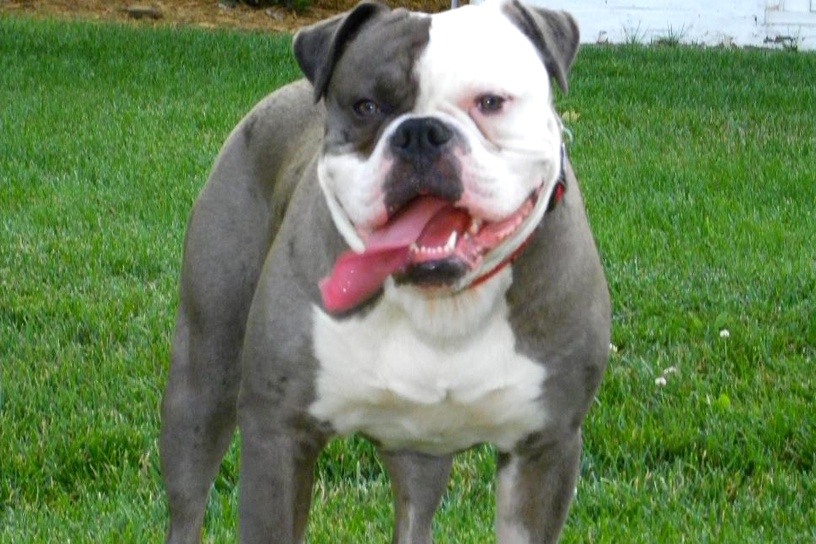
The muscular frame and serious looks of the Alapaha earned him a reputation that darkens the many beautiful qualities of this breed.
Fortunately, many people now see past the outer ruggedness into the loving dog within.
The maxim ‘do not judge a book by its cover applies here. Far from being the aggressive, dangerous breed, Alapaha is loving, loyal, and active.
Alapaha Blue blood bulldogs make good watchdogs and guard dogs.
They are aloof towards strangers and would signal the arrival of a ‘guest’ to the house. When faced with a threat, their courage is enviable.
They will not back down from a fight and would defend their families with all they got.
They are also territorial, a quality that further pumps their guard dog resume. If security is a priority for you, the Alapaha is one of the best security dogs there is.
However, for all their lovely qualities, new owners are not advised to get an Alapaha.
They are stubborn, independent, and dominant, traits that helped them in times past but can be a pain to an owner training them.
If you are not dominant enough with them, they’d want to take over from you, a situation you should never allow.
In a human-dog relationship, humans should remain at the top of the pack, not the dog.
Is an Alapaha Blue Blood Bulldog a good family dog?
An Alapaha Blue blood bulldog is strong, protective, loving, and loyal to family members. They are not selective over their affection and would show love to any member of the family, old and young alike.
They make good household companions, security dogs, and protectors.
You should, however, be sure you’re up to the task of training a bulldog.
They are strong and dominant, which means you should be firm but not harsh with them.
They also love attention, a trait that can become a problem if you are a busy person with a hectic schedule.
The Alapaha is a good family dog, but he isn’t a perfect fit for every dog owner.
Are Alapaha Blue Blood Bulldogs good with kids?
The Alapaha Blue Blood Bulldog is loyal to every member of the family. This includes the kids.
They are protective of children and would defend them from any harm.
They love to be around children too, so you don’t have to worry about them getting aggressive at your ‘babies’.
This breed is ideal to have around children, but your kids should know how to interact well with a dog and show it respect.
Mistreatment of the dog, even during playtime, should not be tolerated.
You should supervise contacts between a child and the Alapaha, as well. While it is true they won’t harm your child, it is best for you to hang around.
Are Alapaha Blue Blood Bulldogs good with other dogs and pets?
With proper training, the Alapaha Bulldog copes well with other dogs in your household. With foreign dogs, however, they tend to get aggressive.
They are territorial and would not feel comfortable having other dogs on their ‘turf’. They get along with other pets like cats if they grew up with these animals.
Do note that they are natural hunters. Keep them in a fenced yard to prevent them from going after your neighbor’s pet.
Male vs Female Alapaha Blue Blood Bulldog
Alapaha Bulldogs are sexually dimorphic. This means that both sexes act and look different.
Unlike some breeds, the difference in sex isn’t limited to their organs or reproductive quality.
While some people know what gender they prefer, others are unsure. If you belong to the latter category, knowing about the differences should help.
The first obvious difference between the male and female Alapaha Blue Bulldog is their weight.
For many dog breeds, the difference is subtle. For the Alapaha, the gap is wide.
Males weigh like 70 to 90 pounds while females are at 55 to 75 pounds. The males are also taller by 2 inches.
Another obvious difference is in their genitals, like with humans and many other breeds.
The male genitals are external and easily seen if you lie them on their back.
This isn’t the same with females. Females can also reproduce, which is good for breeding.
In addition, there are some personality similarities and differences.
While both are loyal, protective, and loving, the male shows more aggression while the female tends to be more territorial.
Should you go for the male or female? It depends on you and what you want from a pet. For instance, if you want a smaller Alapaha, the female is your best option.
There’s a third option many pet parents opt for. It is the surgical procedure of removal of organs.
The common term for this is spaying or neutering. Like many other procedures, there are benefits and side effects.
Consult your veterinarian to know whether or not this third option is for you.
Caring for an Alapaha Blue Blood Bulldog
You’ve probably heard of Maslow’s hierarchy of needs. In a nutshell, what humans need are food, clothing, safety, friendship, esteem, and self-actualization.
If you should group all these in one word, it would be ‘care’.
All living beings have a thing for ‘care’. As babies, we depend on our mothers to feed us. When we become kids, our parents cover our needs.
We grow into adults and gain independence, but the needs never change. The only difference is that we begin to meet these needs ourselves.
Dogs’ needs are similar, and they depend on you from puppyhood to adulthood to meet these needs.
Unlike us, they can’t go out and drop resumes to get a job, nor can they rent an apartment or attend a seminar. While a lot of dogs show independence, you are still responsible for their well-being.
Alapaha Bulldog is an example of an independent dog. With a dominant streak and a penchant for self-autonomy, they may choose to do things their own way.
The problem is, their way may not be the right way. It is up to you to put them on the right path with firm, consistent and loving training.
Socialization is necessary to prevent their aloofness at strangers from becoming unwanted aggression.
This dog breed can do well indoors if they’ve gotten their exercise quota for the day.
They shouldn’t be left alone outdoors because they crave human company and enjoy the attention.
While you’re at that, they need to eat and stay clean. They also should stay healthy, so regular checkup is a must.
Alapaha Blue Blood Bulldog Food and Diet
As we have pointed out, food is an essential need for any dog breed. Without the energy and nutrients food bring, no living being will survive.
There is a healthy way to feed a dog if you want to keep him well. This means you should not just feed them with whatever’s available.
For each breed, there are nutrients and a meal ration you should take note of.
Having said that, there is no rigid feeding rule for any breed. Your individual dog has his culinary habits that would differ from another dog of the same breed.
Some eat slower than others. Some select meals, others don’t. While the tips here can serve as a guideline, a visit to the veterinarian will be beneficial.
An adult Alapaha requires about 3 to 4.5 cups of dry food. The quality matters, as well as the nutrients involved.
Protein, minerals, water, healthy fat, and vitamins are some vital nutrients your Alapaha needs.
While feeding your Alapaha, be conscious of his weight. Obesity brings a lot of problems that should be avoided by being intentional with how you feed your dog.
Also, the age factor should be considered. Puppies should never be given adult food because this can endanger their health.
Senior adults have a unique feeding requirement as well. It should be followed to keep them balanced in their last years.
Alapaha Blue Blood Bulldog Exercise
The Alapaha has a moderate energy level. Thus, he has a normal level of exercise.
This is good if you can’t deal with a highly energetic dog and if you’re not one for strenuous activities.
Nonetheless, they still need a good level of exercise to prevent them from being destructive.
Like other dogs, exercise makes Alapaha Bulldogs fit, healthy, confident, and of a balanced size.
Alapaha needs 40 minutes to an hour of exercise each day. A stroll to a nearby park is a good, all-time exercise with benefits.
While walking with them on a leash, make sure they stay behind, not at the front.
This sends a strong signal that you are the one in charge, not them.
They should not be let off the leash in an unfenced environment or you may find yourself running after your pet as he dashes at a prey.
Additional exercises besides walks are:
- Playing with toys
- Light jogging
- Fetch
- A game of frisbee
- Tug of war
Ensure they get some mental activities as well like puzzles, challenges, and other games they can participate in.
When their exercise need is met, the Alapaha can remain indoors.
Take extra caution when training an Alapaha puppy. They are still in the development phase and should not be allowed to partake in strenuous activities.
Do not let them run as that can damage their bones. A simple 10 minutes walk is a good start. As the puppy grows older, increase the timing.
Senior Alapaha puppies need exercise to manage weight and maintain good health.
Training an Alapaha is not for the faint of heart, nor is it for the inexperienced or the cynophobe.
While he’s a loyal dog and protective, he’s also dominant and will want to challenge your authority.
You must maintain your status as leader of the pack if you will get anywhere with this breed.
Dogs don’t come fully formed. They will not know what is right or wrong, or what should be off-limits for them. Left on their own, they will follow their instincts and act as they please.
You are responsible for your pet and should ensure he/she is domesticated, well mannered, and social. When you fail to do this, you leave society with a canine risk.
The Alapaha is too dominant for a newbie. You need a lot of experience to train them as they won’t be eager to do as you say.
Put them on obedience training and socialization, amidst others.
Start with obedience training while they are puppies. Routines come first, commands follow suit.
Your Alapaha puppy should know where to sleep, where to eat, and some other basic things.
Let your puppy learn new words like ‘no’ for something he shouldn’t do and ‘good’ when he succeeds.
Socialize your Alapaha by getting him outdoors to get accustomed to new sights, smells, and people.
A trip to the dog park to meet new dogs is not a bad idea. If you have friends who own well-trained dogs, schedule a date with them. By observation, your Alapaha can pick good habits.
Other training they need include housebreaking and crate training.
Related: Crate Training Pros and Cons
Alapaha Blue Blood Bulldog Grooming Needs
Alapaha Bulldogs have a short coat similar to other bulldogs. They are low maintenance, so you don’t need to spend on a professional groomer.
This is good news for those who can’t afford the time, effort, and cost of high grooming.
Alapahas are also moderate shedders which is extra good news for prospective owners.
A once in a week brushing will suffice to keep them looking proper. Give them a bath too, when they get dirty.
The teeth should be brushed to prevent toothache and nasty mouth odor. Use a recommended toothpaste and toothbrush.
Nails should be kept short lest they get too long and lead to discomfort for your dog.
If you have no experience trimming nails, we suggest you seek advice from a groomer to avoid accidents.
Also, keep their ears clean by using a cotton ball and an ear cleaner.
Grooming is a good time for some checkups. While you go about brushing and trimming, look out for injuries, sores, unpleasant odors, and other abnormal signs. If your dog shows some signs of discomfort, do not ignore it.
Alapaha Blue Blood Bulldog Health Conditions
All things being equal, Alapaha is a healthy breed with a relatively long life span. Sadly, they are prone to some medical conditions.
While it isn’t a must that every dog under this breed will suffer from these problems, you should know and watch out for them.
Some of the health conditions that affect Alapaha Blue Bood Bulldog include entropion, hip dysplasia, and cherry eye.
Entropion
This is an eye illness that makes the eyelids roll inward. Symptoms include squinting, teary eyes, and mucus.
Left untreated, entropion in dogs can lead to blindness. Surgery can correct it, thankfully.
Hip dysplasia
Hip dysplasia is an inherited condition. It happens when the joint gets loose. Symptoms include pain and abnormal movements.
To prevent this, go through the medical background of any puppy you wish to get. Hip dysplasia treatments include physical therapy, supplements, and weight reduction.
Cherry eye
This happens to Alapaha Bull Dogs when their tear glands get swollen.
It gets itchy and uncomfortable to the dog, which may reach out to scratch it, causing further damage. Surgery is needed to correct this.
Frequently Asked Questions
What are Alapaha Blue Blood Bulldogs known for?
Alapaha Dog breeds originated from the southern parts of the United States of America. In old times, their ancestors were hunters and herders.
Modern-day Alapaha can still do this, but their use has evolved. Though they are not yet recognized by the American Kennel Club, they are known for being good companion dogs, watchdogs, and guard dogs.
How big do Alapaha Blue Blood Bulldogs get?
Alapahas are big dogs, with the males weighing almost twice as much as the females.
Generally, fully grown Alapaha Bulldogs weigh 50 to 90 pounds, though some males get up to 100 pounds. They also grow up to 25 inches.
Do Alapaha Blue Blood Bulldogs like to cuddle?
Alapaha Bulldogs do well indoors and don’t go berserk when their exercise needs are met.
They also like staying close to family and don’t enjoy solitude. However, they are not good cuddle dogs.
Is it hard to care for Alapaha Blue Blood Bulldog?
Alapaha Bulldogs are low maintenance due to their short coat which doesn’t require much brushing or grooming.
They also have a moderate level of exercise and are not hyperactive.
They do well both indoors and outdoors. Thus, they are not hard to take care of.
The only challenges you’d face are training and some health complications.
How long do Alapaha Blue Blood Bulldog live for?
Alapaha Bulldogs have a relatively long lifespan and are likely to stay around for years. They live as long as 11 to 13 years.
How Much do Alapaha Blue Blood Bulldogs cost?
Alapaha Bulldogs are not overly expensive, but they are not cheap either. You can get a puppy at a price range of $1,500 to $1,800.
Do Alapaha Blue Blood Bulldogs shed?
Alapaha Bulldogs have a short coat, so they don’t shed excessively. They are moderate shedders and should be brushed once a week to remove dead hair.
Is an Alapaha Blue Blood Bulldog right for you?
Alapaha Dog breeds are loyal, courageous, loving to family members, and ever ready to defend. They make good companions, observant watchdogs, and good guard dogs.
Alapaha Bulldogs also flow well with kids, co-exists with other dogs and pets when trained, and are not aggressive.
If you can give them firm training and take care of all other needs, the Alapaha is the right dog for you.
Related: Complete Alphabetical List of Dog Breeds
To Wrap Up
Is the Alapaha Blue Blood Bulldog the right dog for you? Only you can answer this question.
We do hope that the Alapaha Blue Blood Bulldog facts, tips, and dog breed information in this article will help make your decision more obvious.
If it has, then good for you.
Overall, the Alapaha is a loyal companion, watchdog, and guard dog who may give you a tough time to train but would also lay his life for you if need be.

